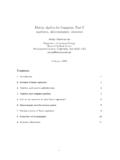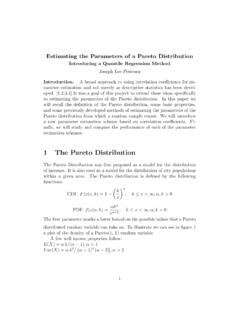Transcription of Solving Linear Programs 2 - Massachusetts Institute of ...
1 Solving Linear Programs2In this chapter, we present a systematic procedure for Solving Linear Programs . This procedure, called thesimplex method,proceeds by moving from one feasible solution to another, at each step improving the valueof the objective function. Moreover, the method terminates after a finite number of such characteristics of the simplex method have led to its widespread acceptance as a computational , the method is robust. It solvesanylinear program; it detects redundant constraints in the problemformulation; it identifies instances when the objective value is unbounded over the feasible region; and itsolves problems with one or more optimal solutions.
2 The method is also self-initiating. It uses itself eitherto generate an appropriate feasible solution, as required, to start the method, or to show that the problem hasno feasible solution. Each of these features will be discussed in this , the simplex method provides much more than just optimal solutions. As byproducts, it indicateshow the optimal solution varies as a function of the problem data (cost coefficients, constraint coefficients,and righthand-side data). This information is intimately related to a Linear program called thedualto thegiven problem, and the simplex method automatically solves this dual problem along with the given characteristics of the method are of primary importance for applications, since data rarely is knownwith certainty and usually is approximated when formulating a problem.
3 These features will be discussed indetail in the chapters to presenting a formal description of the algorithm, we consider some examples. Though elementary,these examples illustrate the essential algebraic and geometric features of the method and motivate the SIMPLEX METHOD A PREVIEWO ptimal SolutionsConsider the following Linear program:Maximizez=0x1+0x2 3x3 x4+20,(Objective 1)subject to:x1 3x3+3x4=6,(1)x2 8x3+4x4=4,(2)xj 0(j=1,2,3,4).Note that as stated the problem has a very special form. It satisfies the following:1.
4 All decision variables are constrained to be All constraints, except for the nonnegativity of decision variables, are stated as Method A Preview393. The righthand-side coefficients are all One decision variable is isolated in each constraint with a+1 coefficient (x1in constraint (1) andx2inconstraint (2)). The variable isolated in a given constraint does not appear in any other constraint, andappears with a zero coefficient in the objective problem with this structure is said to be incanonical form. This formulation might appear to be quitelimited and restrictive; as we will see later, however,anylinear programming problem can be transformed sothat it is in canonical form.
5 Thus, the following discussion is valid for Linear Programs in that, given any values forx3andx4, the values ofx1andx2are determined uniquely by theequalities. In fact, settingx3=x4=0 immediately gives a feasible solution withx1=6 andx2= such as these will play a central role in the simplex method and are referred to asbasic feasiblesolutions. In general, given a canonical form for any Linear program, a basic feasible solution is given bysetting the variable isolated in constraintj, called thejthbasic-variable, equal to the righthand side of thejth constraint and by setting the remaining variables, callednonbasic, all to zero.
6 Collectively the basicvariables are termed abasis. In the example above, the basic feasible solutionx1=6,x2=4,x3=0,x4=0, is optimal. For anyother feasible solution,x3andx4must remain nonnegative. Since their coefficients in the objective functionare negative, if eitherx3orx4is positive,zwill be less than 20. Thus the maximum value forzis obtainedwhenx3=x4= summarize this observation, we state the:Optimality that, in a maximization problem, every nonbasic variable has a non-positive coefficient in the objective function of a canonical form.
7 Then the basic feasible solution givenby the canonical form maximizes the objective function over the feasible Objective ValueNext consider the example just discussed but with a new objective function:Maximizez=0x1+0x2+3x3 x4+20,(Objective 2)subject to:x1 3x3+3x4=6,(1)x2 8x3+4x4=4,(2)xj 0(j=1,2,3,4).Sincex3now has a positive coefficient in the objective function, it appears promising to increase the valueofx3as much as possible. Let us maintainx4=0, increasex3to a valuetto be determined, and updatex1andx2to preserve feasibility.
8 From constraints (1) and (2),x1=6+3t,x2=4+8t,z=20+3t. We have introduced the new termscanonical, basis, andbasic variableat this early point in our discussion becausethese terms have been firmly established as part of Linear -programming a word used in manycontexts in mathematics, as it is here, to mean a special or standard representation of a problem or concept, usuallychosen to facilitate study of the problem or concepts in Linear algebra ; our use of theseterms agrees with Linear - algebra interpretations of the simplex method that are discussed formally in Appendix Linear matter how largetbecomes,x1andx2remain nonnegative.
9 In fact, astapproaches+ ,zapproaches+ . In this case, the objective function is unbounded over the feasible same argument applies to any Linear program and provides the:Unboundedness that, in a maximization problem, some nonbasic variable has apositive coefficient in the objective function of a canonical form. If that variable has negative or zerocoefficients in all constraints, then the objective function is unbounded from above over the a Nonoptimal SolutionFinally, let us consider one further version of the previous problem:Maximizez=0x1+0x2 3x3+x4+20,(Objective 3)subject to:x1 3x3+3x4=6,(1)x2 8x3+4x4=4,(2)xj 0(j=1,2,3,4).
10 Now asx4increases,zincreases. Maintainingx3=0, let us increasex4to a valuet, and updatex1andx2to preserve feasibility. Then, as before, from constraints (1) and (2),x1=6 3t,x2=4 4t,z=20+ to remain nonnegative, we require:6 3t 0,that is,t 63=2and4 4t 0,that is,t 44= , the largest value fortthat maintains a feasible solution ist=1. Whent=1, the new solutionbecomesx1=3,x2=0,x3=0,x4=1, which has an associated value ofz=21 in the that, in the new solution,x4has a positive value andx2has become zero. Since nonbasic variableshave been given zero values before, it appears thatx4has replacedx2as a basic variable.


















